Accumulation of salicylic acid and 4-hydroxybenzoic acid in phloem fluids of cucumber during systemic acquired resistance is preceded by a transient increase in phenylalanine ammonia-lyase activity in petioles and stems
- PMID: 9449843
- PMCID: PMC35162
- DOI: 10.1104/pp.116.1.231
Accumulation of salicylic acid and 4-hydroxybenzoic acid in phloem fluids of cucumber during systemic acquired resistance is preceded by a transient increase in phenylalanine ammonia-lyase activity in petioles and stems
Abstract
Cucumber (Cucumis sativa) leaves infiltrated with Pseudomonas syringae pv. syringae cells produced a mobile signal for systemic acquired resistance between 3 and 6 h after inoculation. The production of a mobile signal by inoculated leaves was followed by a transient increase in phenylalanine ammonia-lyase (PAL) activity in the petioles of inoculated leaves and in stems above inoculated leaves; with peaks in activity at 9 and 12 h, respectively, after inoculation. In contrast, PAL activity in inoculated leaves continued to rise slowly for at least 18 h. No increases in PAL activity were detected in healthy leaves of inoculated plants. Two benzoic acid derivatives, salicylic acid (SA) and 4-hydroxybenzoic acid (4HBA), began to accumulate in phloem fluids at about the time PAL activity began to increase, reaching maximum concentrations 15 h after inoculation. The accumulation of SA and 4HBA in phloem fluids was unaffected by the removal of all leaves 6 h after inoculation, and seedlings excised from roots prior to inoculation still accumulated high levels of SA and 4HBA. These results suggest that SA and 4HBA are synthesized de novo in stems and petioles in response to a mobile signal from the inoculated leaf.
Figures
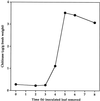

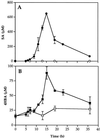
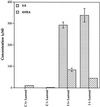
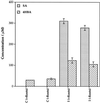


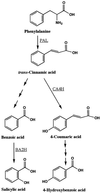
Similar articles
-
Changes in specific activities of peroxidase, chitinase and phenylalanine ammonia-lyase and phenolic content in cucumber leaves inoculated with Podosphaera fusca, the causal agent of powdery mildew.Commun Agric Appl Biol Sci. 2004;69(4):545-53. Commun Agric Appl Biol Sci. 2004. PMID: 15756838
-
Salicylic acid and cysteine contribute to arbutin-induced alleviation of angular leaf spot disease development in cucumber.J Plant Physiol. 2015 Jun 1;181:9-13. doi: 10.1016/j.jplph.2015.03.017. Epub 2015 Apr 17. J Plant Physiol. 2015. PMID: 25955697
-
Systemic Induction of Salicylic Acid Accumulation in Cucumber after Inoculation with Pseudomonas syringae pv syringae.Plant Physiol. 1991 Dec;97(4):1342-7. doi: 10.1104/pp.97.4.1342. Plant Physiol. 1991. PMID: 16668554 Free PMC article.
-
Salicylic acid as a signal molecule in plant-pathogen interactions.Curr Opin Cell Biol. 1994 Apr;6(2):275-9. doi: 10.1016/0955-0674(94)90147-3. Curr Opin Cell Biol. 1994. PMID: 8024819 Review.
-
Salicylic acid: a systemic signal in induced plant disease resistance.Trends Microbiol. 1993 Jun;1(3):88-92. doi: 10.1016/0966-842x(93)90113-6. Trends Microbiol. 1993. PMID: 8143122 Review.
Cited by
-
Involvement of a PadR regulator PrhP on virulence of Ralstonia solanacearum by controlling detoxification of phenolic acids and type III secretion system.Mol Plant Pathol. 2019 Nov;20(11):1477-1490. doi: 10.1111/mpp.12854. Epub 2019 Aug 8. Mol Plant Pathol. 2019. PMID: 31392803 Free PMC article.
-
Phased small RNA-mediated systemic signaling in plants.Sci Adv. 2022 Jun 24;8(25):eabm8791. doi: 10.1126/sciadv.abm8791. Epub 2022 Jun 24. Sci Adv. 2022. PMID: 35749505 Free PMC article.
-
Genetic background of host-pathogen interaction between Cucumis sativus L. and Pseudomonas syringae pv. lachrymans.J Appl Genet. 2009;50(1):1-7. doi: 10.1007/BF03195645. J Appl Genet. 2009. PMID: 19193976 Review.
-
Biochemical Evaluation of Phenylalanine Ammonia Lyase from Endemic Plant Cyathobasis fruticulosa (Bunge) Aellen. for the Dietary Treatment of Phenylketonuria.Food Technol Biotechnol. 2016 Sep;54(3):296-303. doi: 10.17113/ftb.54.03.16.4519. Food Technol Biotechnol. 2016. PMID: 27956861 Free PMC article.
-
Detection of Potential Chloroplastic Substrates for Polyphenol Oxidase Suggests a Role in Undamaged Leaves.Front Plant Sci. 2017 Mar 3;8:237. doi: 10.3389/fpls.2017.00237. eCollection 2017. Front Plant Sci. 2017. PMID: 28316605 Free PMC article.
References
-
- Boller T, Metraux JP. Extracellular localization of chitinase in cucumber. Physiol Mol Plant Pathol. 1988;33:11–16.
-
- Bradford MM. A rapid and sensitive method for the quantitation of microgram quantities of protein utilizing the principles of protein-dye binding. Anal Biochem. 1976;72:248–254. - PubMed
-
- Cameron R, Dixon R, Lamb C. Biologically induced systemic acquired resistance in Arabidopsis thaliana. Plant J. 1994;5:715–725.
Publication types
MeSH terms
Substances
LinkOut - more resources
Full Text Sources

